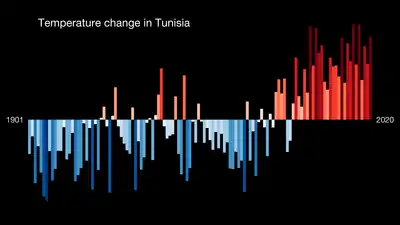Climate of Tunisia
The climate of Tunisia is Mediterranean in the north, with mild rainy winters and hot, dry summers.[1] The south of the country is desert. The terrain in the north is mountainous, which, moving south, gives way to a hot, dry central plain. The south is semiarid, and merges into the Sahara. A series of salt lakes, known as chotts or shatts, lie in an east–west line at the northern edge of the Sahara, extending from the Gulf of Gabes into Algeria. The lowest point of the Tunisian landscape is located at Chott el Djerid, which stands at 17 metres (56 ft) below sea level and the highest point is Jebel ech Chambi, at 1,544 metres (5,066 ft) above sea level.[2]

Details

Tunisia's climate is divided into seven bioclimatic zones, with the main difference between the north and the rest of the country being due to the Tunisian hills which separate the regions subject to a Mediterranean climate and a typical hot desert climate of the Sahara - the largest hot desert in the world. Between them, there is a semi-arid climate with common characteristics between the two main climatic systems in the country.[3][4]
Tunisia's climate is affected by various types of wind due to its geographical location: the northern coast is exposed to moderate and humid sea winds blowing from southern France, resulting in a significant decrease in temperatures and an increase in rainfall. In the south of the country, there are hot and dry continental winds, such as the Chergui wind, which blows over large desert areas causing a sudden rise in temperatures and a clear dry atmosphere. The country also benefits from a high amount of sunshine, exceeding 3000 hours per year, which reaches its peak in the southern desert, on the Algerian and Libyan borders.[5]
Temperatures vary according to latitude, longitude, and proximity to the Mediterranean Sea. While temperatures can drop below 0 degrees Celsius in the winter in the Khemer Mountains (Kroumirie), the maximum temperature often rises to around 50 degrees Celsius in the desert regions in the summer. Average annual rainfall also varies by region, from about 1000 mm in the north to about 380 mm in the center and down to less than 50 mm in the far south.
The country has approximately 16361 acres, 9700.5 acres of agricultural land and 701.2 acres of forested land.[6]
Climate change

Tunisia has experienced a significant increase in temperatures over the 20th and early 21st centuries, with the average temperature rising by approximately 1.2 °C from 1901 to 2020.[7] This trend of rising temperatures is expected to continue, leading to numerous impacts on the country's ecosystems, agriculture, and human health.[8]
The limited water resources available in Tunisia means that the country is very susceptible to small changes in ambient temperature that result in the even further reduced water availability. This makes the agricultural activities more vulnerable to the effects of climate change. [9] Research has found that an increase of 1°C per year leads to an annual decrease of income by $19.90 per hectare in Tunisia.
Climate change affects cities more-so than urban areas. This observed global average is present in Tunisia as well. The ventures in the urban areas are massive contributors to climate change.[10] According to the UN Habitat, 2021, city areas account for about 70% of CO2 emissions.[11] In the coming decades, millions of people in urban areas are likely to be affected by rising sea levels, increased precipitation, inland floods, more frequent and stronger cyclones and storms, and periods of more extreme weather events.[12]
The Mediterranean is one of the regions of the world most affected by the effects of climate change. Mediterranean temperatures are increasing 20% faster than the global average (WWF 2021).[13]
Cultural Impacts and Tunisia's Environment
The coastal regions of Tunisia have a Mediterranean climate, which allows the production and cultivation of fruits, like grapes and vineyards, and olives. However, the country of Tunisia is large and also has zones of desert where farming techniques have adapted to flourish among low rainfall and extreme heat.
Because of Tunisia’s diverse climate and gorgeous seaside attractions, tourists visit the country year-round. The blue water of the Mediterranean sea draws individuals seeking beach vacations in summer. Meanwhile Tunisia’s mild winters also allow individuals to explore the country's cities, culture, and museums.
As previously mentioned, Tunisia lies within a desert and is quite hot. During the summer months of August and June, the heat lingers around an average temperature of 94 degrees Fahrenheit (34.4 Celsius)[14][15]. For Tunisia’s inhabitants to deal with the extreme heat of the desert, architecture in southern Tunisia often includes thick, insulated walls and structures to keep interiors cool.
Data
| Tunisia | ||||||||||||||||||||||||||||||||||||||||||||||||||||||||||||
|---|---|---|---|---|---|---|---|---|---|---|---|---|---|---|---|---|---|---|---|---|---|---|---|---|---|---|---|---|---|---|---|---|---|---|---|---|---|---|---|---|---|---|---|---|---|---|---|---|---|---|---|---|---|---|---|---|---|---|---|---|
| Climate chart (explanation) | ||||||||||||||||||||||||||||||||||||||||||||||||||||||||||||
| ||||||||||||||||||||||||||||||||||||||||||||||||||||||||||||
References
- "Climate of Tunisia". BBC. Archived from the original on 9 February 2011. Retrieved 2 May 2010.
- Aldosari, Ali (2006). Middle East, western Asia, and northern Africa. Marshall Cavendish. pp. 1270–. ISBN 978-0-7614-7571-2.
- Baourakis, George; Kalaitzis, Prodromos; Mattas, Konstadinos (2014-01-02). Food Chains: Quality, Safety and Efficiency in a Challenging World. Routledge. ISBN 978-1-317-99513-5.
- Kuenzer, Claudia; Dech, Stefan (2013-06-17). Thermal Infrared Remote Sensing: Sensors, Methods, Applications. Springer Science & Business Media. ISBN 978-94-007-6639-6.
- Hassanien, Aboul Ella; Darwish, Ashraf (2023-03-11). The Power of Data: Driving Climate Change with Data Science and Artificial Intelligence Innovations. Springer Nature. ISBN 978-3-031-22456-0.
- "FAO Country Profiles:Tunisia". Food and Agriculture Organization of the United Nations. Retrieved 2023-10-20.
- "Regional Climate Change: Tunisia". Berkeley Earth. Retrieved 2023-03-14.
- Bouatrous, Asma; Harbaoui, Kalthoum; Karmous, Chahine; Gargouri, Samia; Souissi, Amir; Belguesmi, Karima; Cheikh Mhamed, Hatem; Gharbi, Mohamed Salah; Annabi, Mohamed (2022-06-17). "Effect of Wheat Monoculture on Durum Wheat Yield under Rainfed Sub-Humid Mediterranean Climate of Tunisia". Agronomy. 12 (6): 1453. doi:10.3390/agronomy12061453. ISSN 2073-4395.
- "Impact of Climate Change on Date Production in - ProQuest". www.proquest.com. Retrieved 2023-10-25.
- Ben Youssef, Adel (2022-10-13). "Climate change in the Tunisian cities: lessons learned and best practices". Environmental Economics and Policy Studies. doi:10.1007/s10018-022-00353-x. ISSN 1432-847X. PMC 9559540.
- Ben Youssef, Adel (2022-10-13). "Climate change in the Tunisian cities: lessons learned and best practices". Environmental Economics and Policy Studies. doi:10.1007/s10018-022-00353-x. ISSN 1432-847X. PMC 9559540.
- Ben Youssef, Adel (2022-10-13). "Climate change in the Tunisian cities: lessons learned and best practices". Environmental Economics and Policy Studies. doi:10.1007/s10018-022-00353-x. ISSN 1432-847X. PMC 9559540.
- Ben Youssef, Adel (2022-10-13). "Climate change in the Tunisian cities: lessons learned and best practices". Environmental Economics and Policy Studies. doi:10.1007/s10018-022-00353-x. ISSN 1432-847X. PMC 9559540.
- "94 degrees Fahrenheit to Celsius - Temperature Conversion". www.vacations.info. Retrieved 2023-10-20.
- "Appendix 3: Temperature Conversion from Celsius Scale to Fahrenheit Scale", Advanced Energy Systems, CRC Press, pp. 585–586, 2013-12-20, ISBN 978-0-429-15834-6, retrieved 2023-10-20
- "Weatherbase : Tunisia". Archived from the original on 2021-09-06. Retrieved 13 May 2016.